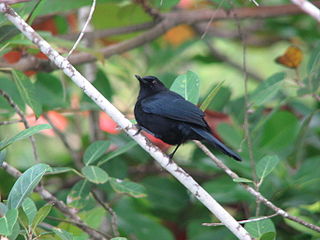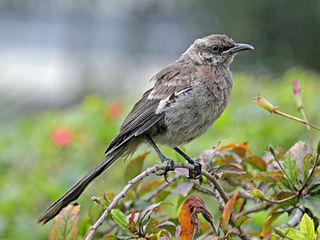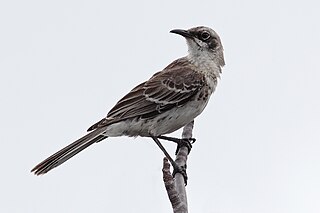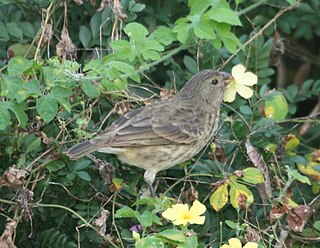
The mimids are the New World family of passerine birds, Mimidae, that includes thrashers, mockingbirds, tremblers, and the New World catbirds. As their name suggests, these birds are notable for their vocalization, especially some species' remarkable ability to mimic a wide variety of birds and other sounds heard outdoors. They are commonly referred to as mimic thrushes but are not, in fact, thrushes.

Mockingbirds are a group of New World passerine birds from the family Mimidae. They are best known for the habit of some species mimicking the songs of other birds and the sounds of insects and amphibians, often loudly and in rapid succession. There are about 17 species in two genera, although three species of mockingbird from the Galapagos Islands were formerly separated into a third genus, Nesomimus. The mockingbirds do not appear to form a monophyletic lineage, as Mimus and Melanotis are not each other's closest relatives; instead, Melanotis appears to be more closely related to the catbirds, while the closest living relatives of Mimus appear to be thrashers, such as the sage thrasher.

Darwin's finches are a group of about 18 species of passerine birds. They are well known for their remarkable diversity in beak form and function. They are often classified as the subfamily Geospizinae or tribe Geospizini. They belong to the tanager family and are not closely related to the true finches. The closest known relative of the Galápagos finches is the South American dull-coloured grassquit. They were first collected when the second voyage of the Beagle visited the Galápagos Islands, with Charles Darwin on board as a gentleman naturalist. Apart from the Cocos finch, which is from Cocos Island, the others are found only on the Galápagos Islands.

The northern mockingbird is a mockingbird commonly found in North America. This bird is mainly a permanent resident, but northern birds may move south during harsh weather. This species has rarely been observed in Europe. This species was first described by Carl Linnaeus in his 1758 10th edition of Systema Naturae as Turdus polyglottos. The northern mockingbird is known for its mimicking ability, as reflected by the meaning of its scientific name, "many-tongued mimic". The northern mockingbird has gray to brown upper feathers and a paler belly. Its tail and wings have white patches which are visible in flight.

The Socorro mockingbird is an endangered mockingbird endemic to Socorro Island in Mexico's Revillagigedo Islands. The specific epithet commemorates the American ornithologist Andrew Jackson Grayson.

The Galápagos hawk is a large hawk endemic to most of the Galápagos Islands.

Pyrocephalus is a genus of bird in the tyrant flycatcher family, Tyrannidae.

David William Snow was an English ornithologist born in Windermere, Westmorland.

Geospiza is a genus of bird in the tanager family Thraupidae. All species in the genus are endemic to the Galápagos Islands. Together with related genera, they are collectively known as Darwin's finches. Although in the past, they were classified in the bunting and American sparrow family Emberizidae, more recent studies have shown they belong in the tanager family.

The small ground finch is a species of bird in the tanager family Thraupidae. Endemic to the Galápagos Islands, it is common and widespread in shrubland, woodland, and other habitats on most islands in the archipelago. It commonly feeds on small seeds and parasites from the skins of Galápagos land and marine iguanas and Galápagos tortoises.

The black catbird is a songbird species in the monotypic genus Melanoptila, part of the family Mimidae. At 19–20.5 cm (7.5–8.1 in) in length and 31.6–42 g (1.11–1.48 oz) in mass, it is the smallest of the mimids. Sexes appear similar, with glossy black plumage, black legs and bill, and dark brownish eyes. The species is endemic to the Yucatán Peninsula, and is found as far south as Campeche, northern Guatemala and northern Belize. Although there are historical records from Honduras and the US state of Texas, the species is not now known to occur in either location. It is found at low elevations in semi-arid to humid habitats ranging from shrubland and abandoned farmland to woodland with thick understory, and is primarily sedentary.

The blue mockingbird is a species of bird in the family Mimidae. It is endemic to Mexico, but has occurred as a vagrant in the southern United States. Its natural habitats are subtropical or tropical dry forests, subtropical or tropical moist montane forests, and heavily degraded former forest.

The long-tailed mockingbird is a species of bird in the family Mimidae. It is found in Ecuador and Peru.

The Hood mockingbird, also known as the Española mockingbird, is a species of bird in the family Mimidae. It is endemic to Española Island in the Galápagos Islands, Ecuador, and it is one of four closely related mockingbird species endemic to the Galápagos archipelago. It is found in dry forests and is omnivorous, though it primarily is a carnivore or scavenger. The species has a highly territorial social structure and has no fear of humans. It is the only species of Galápagos mockingbird that Charles Darwin did not see or collect on the voyage of the Beagle.

The San Cristóbal mockingbird or Chatham mockingbird, is a species of bird in the family Mimidae. It is endemic to San Cristóbal Island in the Galápagos Islands.

The Galápagos mockingbird is a species of bird in the family Mimidae. It is endemic to the Galápagos Islands, Ecuador.

The Floreana mockingbird or the Charles Island mockingbird, is a species of bird in the family Mimidae. It was endemic to Floreana, one of the Galápagos Islands, but now is found only on two nearby islets, Campeón and Gardner-near-Floreana. The Floreana mockingbird is also known as Darwin's mockingbird, as it was the arguable inspiration for Charles Darwin's work on the origins of species; he noticed distinct differences between them and previous species he had encountered and consequently established the existence of other variants on neighboring islands.

The vegetarian finch is a species of bird in the Darwin's finch group of the tanager family Thraupidae endemic to the Galápagos Islands. It is the only member of the genus Platyspiza.

The warbler-finches are a genus Certhidea of birds in the tanager family Thraupidae that are endemic to the Galápagos Islands. Together with related genera, they are collectively known as Darwin's finches.



















